光电印制电路板多处理器低能耗建筑模型(IJEME-V2-N4-3)
超低能耗办公建筑能耗模拟分析

- 146 -生 态 与 环 境 工 程0 引言由于环境恶化,世界能源短缺,各国开始大力发展节能建筑,如超低能耗建筑、近零能耗建筑以及零能耗建筑等。
在欧洲各国,被动式超低能耗建筑已经普及,从2020年12月31日起,欧盟的27个国家要求所有新建建筑必须采用被动式超低能耗建筑的建设标准[1],美国要求“零能耗建筑”在2025年商业化,通过推动“净零能耗公共建筑倡议”,到2030年所有新建公共建筑达到净零能耗状态,到2050年所有公共建筑达到净零能耗[2]。
我国对相应建筑的研究较晚,从20世纪80年代才开始,虽然建立了多个示范项目,出台了多项政策,但是我国相应的技术规范和设计标准体系并不完善。
国内的超低能耗建筑大多数以居住建筑为主,公共建筑相对较少,且因公共建筑的类型众多,情况相对复杂,用单一的能耗及热工指标去分析并准确描述相应的能效水平已经无法实现,需要对每种类型的建筑进行研究,从而得到相应的指标[3]。
该文通过运用Design Builder 能耗软件,对山东省某超低能耗办公楼进行模拟计算以及能耗分析,为设计超低能耗建筑提供研究方向,同时为制定山东省公共建筑超低能耗标准提供参考价值。
1 工程概况该项目位于山东省潍坊市,为多层公共建筑,主楼地上主体为三层。
一层设置休闲区和值班室,中庭一直通至屋面,顶部为采光窗;一层、二层分别为办公区、卫生间、新风机房;三层为办公室、会议室、卫生间以及新风机房。
建筑高度为17.6m,建筑面积为8364 m 2。
为达到超低能耗建筑的节能设计要求,在保证室内环境舒适的前提下,消耗更少的能源,该工程的设计要点如下。
1)围护结构具有高气密性以及良好的保温性能。
2)无热桥设计。
3)新风的热回收效率高。
4)合理利用日照以及自然通风。
2 模型建立常规设计中,在计算建筑物的负荷时,只需要计算最大冷负荷及热负荷即可,但是超低能耗建筑因为其特性,室内温度场的变化与常规建筑相比,要有延迟和衰减,能耗较常规建筑少,常规设计不再能满足设计要求,因此需要对建筑物进行全年逐时负荷分析。
EnergyPlus能耗模拟软件及其应用工具_冯晶琛

收稿日期:2011-09-14;修回日期:2011-09-24*基金项目:广州市教育局科技计划项目(项目编号:08C052)0引言能源问题已经成为我国现代化建设的一个重大挑战,随着我国建筑总量的不断攀升和居住舒适度的提升,建筑能耗呈现急剧上升趋势,建筑耗能在我国总能源消耗的比例不断增加。
我国建筑围护结构保温隔热性能差,采暖空调系统效率低,导致单位建筑面积能耗为发达国家新建建筑的3倍以上。
正确分析建筑能耗,对于合理地利用能源,保护生态环境,促进经济的可持续发展均具有重大的现实意义和理论价值[1]。
建筑节能的核心是建造低能耗的建筑,涉及建筑围护结构、建筑设备系统等许多方面,因此,在建筑设计阶段,必须对建筑物的能耗,尤其是全年运行的动态能耗进行模拟,这使得各种建筑能耗模拟软件应运而生。
1能耗模拟软件现状迄今世界各国都意识到能耗模拟分析的重要性。
从20世纪60年代到今天,随着计算机技术的发展完善,能耗动态模拟分析计算方法的日趋成熟,很多国家都根据自己的特点及要求研发了建筑能耗计算程序,可以很方便地对建筑物进行全年动态模拟。
美国是开展建筑节能研究最早的国家之一,与节能标准相关的软件有120多种,有关建筑节能评估的有70多种。
其中具代表性的是美国能源部(DOE)和美国劳伦斯伯克利国家实验室(LBNL)研发的DOE-2及基于DOE-2内核的应用软件(如PowerDOE 、VisualDOE 、EZDOE 、DesiCalc)、伊利诺斯大学研发的BLAST (Building Loads Analysis and System Thermodynamics)、美国可持续建筑工业委员会(Sustainable Buildings Industry Council)主持开发的Energy-10、得克萨斯建筑工程大学建筑学院(College of Architecture Texas A&M University)开发的ENER-WIN 、美国劳伦斯伯克利国家实验室(Lawrence Berkeley National Laborato-ry)开发的SPARK (Simulation Problem Analysis and Research Kernel),以及威斯康星大学太阳能实验室(Solar Energy Laboratory ,University of Wisconsin)开发的TRNSYS(Transient System Simulation Program)等[2]。
严寒地区居住建筑低能耗共享空间布局分析
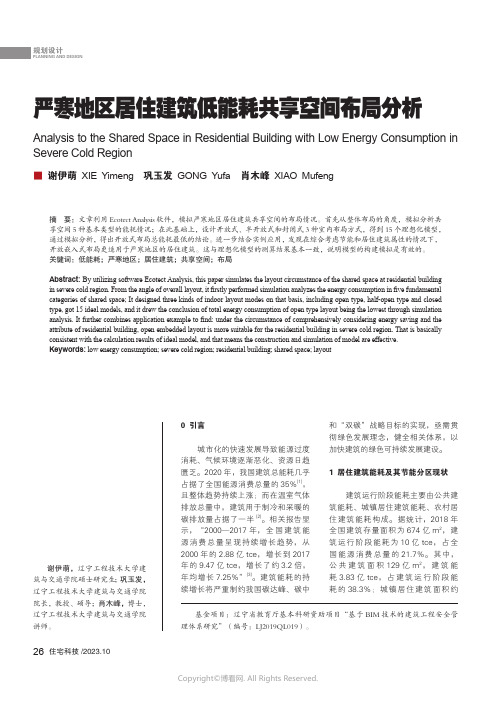
特征,兼具交通和交往等功能;从精 神角度,共享空间是人类身在建筑内 部空间与自然环境沟通的桥梁 [7]。因 此,共享空间设计既是基于人性化、 灵活化的设计语言,也是将“外部环 境、建筑主体、人”三者联系起来的 媒介。其兼具物质和精神两个层面的 作用,可解决城市现有居住模式中缺 乏邻里互动的问题,引发了共享空间 应用于居住建筑的思考。由于共享空 间常使用通透材质,热阻较小,容易 受外界气候的影响而产生大量能耗, 因此在居住建筑共享空间的设计中, 不可盲目跟风,应努力挖掘其潜在的 特性,探索合适的设计方案。
(3)共享空间对风环境也会造 成影响。其作为建筑内外环境之间的 媒 介, 会 形 成 一 定 条 件 下 的 热 压 通 风,从而产生正向效应。但不同的布 局方式会影响共享空间的通风能力, 当共享空间的高宽比较大,且与外界 主导风向形成了适宜的风压通风时, 风压通风就会与热压通风结合,形成 一种更加有效的通风模式。 4.2 共享空间基本类型
共享空间主要分为嵌入式、贯通 式、核心式、并置式、外包式等 5 种 基本类型(图 1),其中:贯通式常 应用于商业属性较强的建筑;并置式 和外包式更适用于和周边环境互动、 交互频率较高的大型建筑;嵌入式与 核心式则应用广泛,常见的建筑类型 中基本都有采用。 4.3 整体布局下 5 种基本类型共享空 间能耗模拟
Abstract: By utilizing software Ecotect Analysis, this paper simulates the layout circumstance of the shared space at residential building in severe cold region. From the angle of overall layout, it firstly performed simulation analyzes the energy consumption in five fundamental categories of shared space; It designed three kinds of indoor layout modes on that basis, including open type, half-open type and closed type, got 15 ideal models, and it drew the conclusion of total energy consumption of open type layout being the lowest through simulation analysis. It further combines application example to find: under the circumstance of comprehensively considering energy saving and the attribute of residential building, open embedded layout is more suitable for the residential building in severe cold region. That is basically consistent with the calculation results of ideal model, and that means the construction and simulation of model are effective. Keywords: low energy consumption; severe cold region; residential building; shared space; layout
基于功耗最小的光电多芯片组件优化划分算法
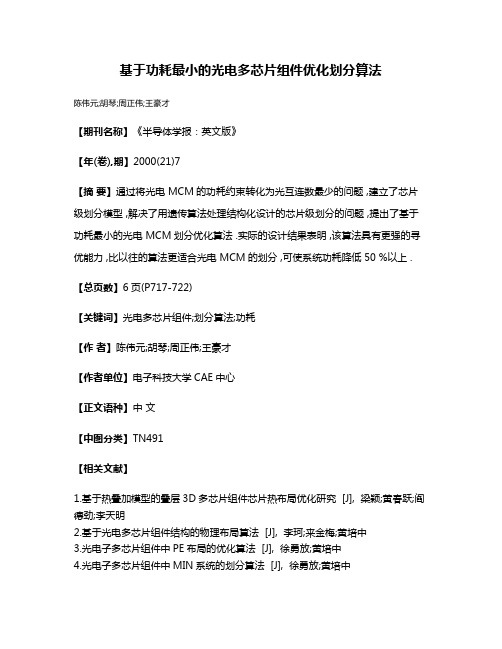
基于功耗最小的光电多芯片组件优化划分算法
陈伟元;胡琴;周正伟;王豪才
【期刊名称】《半导体学报:英文版》
【年(卷),期】2000(21)7
【摘要】通过将光电 MCM的功耗约束转化为光互连数最少的问题 ,建立了芯片级划分模型 ,解决了用遗传算法处理结构化设计的芯片级划分的问题 ,提出了基于功耗最小的光电 MCM划分优化算法 .实际的设计结果表明 ,该算法具有更强的寻优能力 ,比以往的算法更适合光电 MCM的划分 ,可使系统功耗降低 50 %以上 .【总页数】6页(P717-722)
【关键词】光电多芯片组件;划分算法;功耗
【作者】陈伟元;胡琴;周正伟;王豪才
【作者单位】电子科技大学CAE中心
【正文语种】中文
【中图分类】TN491
【相关文献】
1.基于热叠加模型的叠层3D多芯片组件芯片热布局优化研究 [J], 梁颖;黄春跃;阎德劲;李天明
2.基于光电多芯片组件结构的物理布局算法 [J], 李珂;来金梅;黄培中
3.光电子多芯片组件中PE布局的优化算法 [J], 徐勇放;黄培中
4.光电子多芯片组件中MIN系统的划分算法 [J], 徐勇放;黄培中
5.基于S域RLC传输线模型的多芯片组件互连功耗计算(英文) [J], 董刚;杨银堂;李跃进
因版权原因,仅展示原文概要,查看原文内容请购买。
基于用电大数据的光电建筑最佳光伏装机容量的估算研究
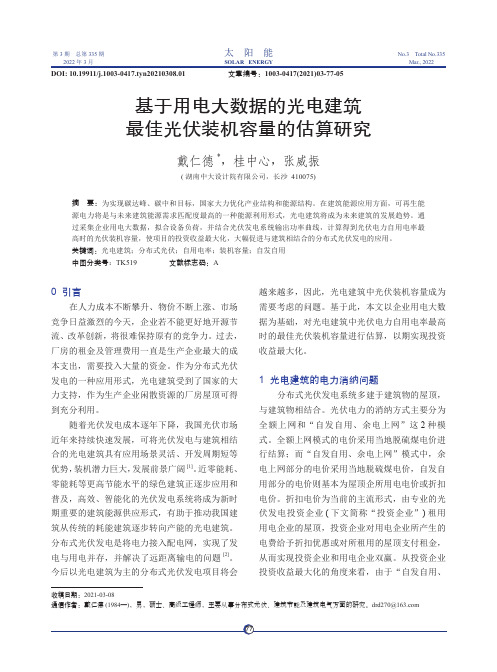
79
技术应用
太阳能
2022 年
用电负荷;输出功率 /kW ᅮ୲/%
率曲线相比较为平稳。 2.4 电力消纳分析
2.4.1 计算参数说明 1) 由于光伏发电系统的检修等工作一般会安
排在晚上进行,避开了自发自用部分的限电,且
项目所在地的电力消纳情况良好,余电上网部分
不存在消纳压力。
2) 由于利用 Meteonorm7.3 软件模拟得到的 光伏发电系统的首年理论发电小时数 982.36 h 属 于理论值,考虑到光伏组件衰减、光伏发电量逐
326589
161307
639741
185380
11
283900
157456
577044
160800
12
302997
133396
570963
140740
注:因有 2 个回路进线,所以用 2 个电表进行用电量统计;电表 1 和电表 2 统计的用电量为峰、平时段的用电量,而总用 电量为峰、平、谷时段的用电量
由于每个省份的电价存在差异,因此需查询
模拟软件,在软件界面输入上述所有参数数据, 项目所在地的峰段、平段、谷段时的电价。当光
以特定模型的算法模拟得出单位量下的光伏发电 系统输出功率曲线、每年的光伏发电量、目标企
伏发电系统的系统效率取 0.82 、项目所在地的太 阳辐照量取 1198 kWh/m2 时,根据《光资源分析
收稿日期:2021-03-08 通信作者:戴仁德 (1984—),男,硕士、高级工程师,主要从事分布式光伏、建筑节能及建筑电气方面的研究。drd270@
77
技术应用
太阳能
2022 年
余电上网”模式的整体收益高于全额上网模式, 尤其是自用电率较高时的投资收益更好 [3]。因此,
研究与实践国际服务外包人才培养(IJEME-V2-N4-6)

I.J. Education and Management Engineering 2012, 4, 34-38Published Online April 2012 in MECS ()DOI: 10.5815/ijeme.2012.04.06Available online at /ijemeResearch and Practice on International Service Outsourcing TalentsCultivationHong Bao a, Tao Peng b, Jun Zhang c, Chang Liu da Institute of Information Technology, Beijing Union University, Beijing, Chinab,c,d School of Information, Beijing Union University, Beijing, ChinaAbstractBased on “National Service Outsourcing Talents Cultivat ing Model Innovation Experimental Zone” project, research and practice on international service outsourcing talents cultivation are carried out in School of Information of Beijng Union University. The standards of service outsourcing talents are studied and curriculum reform is implemented in accordance with the standards. Furthermore, other various forms of outsourcing talents cultivation measures are put forward, such as cross-cultural education program, teachers exchange with foreign universities and bilingual teaching, customized talents cultivation cooperation with international famous enterprises and so on. Through a series of reform measures, students not only have the expertise of the information service outsourcing talents, but also have broad international perspective, good cross-cultural communication ability, excellent teamwork skills, and career aptitude.Index Terms: service outsourcing; talents cultivation; innovation experimental zone; internationalization© 2012 Published by MECS Publisher. Selection and/or peer review under responsibility of the International Conference on E-Business System and Education Technology1.IntroductionService outsourcing refers to the economic activity that the enterprise separates the fundamental, common, and non-core IT business and IT business process from its original value chain, and outsources the business to professional service providers outside the enterprise. In brief, it is a manner to reduce costs of enterprise, transfer risk, and enhance the core competitiveness. In the various forms of service outsourcing, offshore outsourcing is the most important one in many developed countries in Europe and America due to its absolute cost advantage. From the end of 1980s, developed countries started to outsource information technology to India, China and other developing countries in large scale, namely Information Technology Outsourcing (ITO). From the end of 20th century, developed countries started to outsource gradually a variety of business process services based on information technology (such as finance, customer care, human resources, procurement, marketing, etc.) to developing countries, namely Business Process Outsourcing (BPO) [1]. Offshore service outsourcing (ITO and * Corresponding author.E-mail address: a baohong@; c xxtzhangjun@BPO) can not only create more employment opportunities and improve China's import and export trade, but also promote the development of software industry and talents cultivation of information technology.Service outsourcing industry needs a large number of talents who are familiar with business process standards and the global economy management. Therefore it is necessary to cultivate talents who have a broad internationalized vision, the excellent professional skill, the ability of cross-cultural understanding and the ability for teamwork to meet the requirement of service outsourcing enterprises[2]. Based on National “Service Outsourcing Talents Cultivating Model Innovation Experimental Zone” project, resear ch and practice on international service outsourcing talents cultivation are carried out in School of Information of Beijing Union University and a lot of achievements have been obtained.2.Exploration and practice on international service outsourcing talents cultivation2.1Study on the Standards of Service Outsourcing TalentsIn many traditional universities of China, computer courses are updated slowly and some of them are less practical. The lack of talent standards results that the service outsourcing talents cultivation is out of touch with business needs, and thus seriously affects the rapid development of service outsourcing industry. Therefore, it is necessary to constitute standards of service outsourcing talent [3].SFIA(The Skills Framework for the Information Age)is a mandatory standard for software talents that engaged in outsourcing service industry. SFIA is proposed by the United Kingdom, improved by Ireland and approved by the European Union. According to SFIA, the software talents are divided into seven levels and a total of 78 knowledge structures. SFIA will become the mandatory standard for BPO enterprises in EU since 2011, i.e. companies to undertake European BPO projects must have the well-trained workforce that meet SFIA standards [4]. In accordance with the regulations of the Government of Japan, Japanese outsourcing business employees need to have the skills required by ITSS (IT Skill Standard). According to ITSS, the software talents are divided into 11 species and each species has 7 levels respectively, which defines the level of talents from job types, reach index, skill areas and skill proficiency.There is no unified talent standard for information service industry in China. In order to promote information service talent cultivating, the related industry management department is working with Tsinghua University and other institutes to develop standards for information service industry. “Registration Outsourcing Professional Certificate” is carried out by Na tional Outsourcing Certification Industry Management Center. We set up “National Software and Information Service Outsourcing Talent Incubator Base” together with Software and Integrated Circuit Promotion Center of Ministry of Industry and Information Technology and several internationally renowned IT companies. Based on the related criteria of Ministry of Industry and Information Technology and SFIA of EU and ITSS of Japan, investigation and analysis of the service outsourcing industry are carried out and talent skill standards that are suitable to the actual circumstances of China are being under development. Some of the research achievements have been applied to our professional cultivation program.2.2Curriculum System Reform based on Service Outsourcing Talent StandardScientific curriculum system is very important for talents cultivating. In terms of knowledge structure, ability training and career aptitude, curriculum systems of computer discipline in many Chinese Universities and software institutes are not reasonable for cultivating talents required by international service outsourcing talent standards.To construct Information Service discipline, we try to combine several disciplines together, such as Computer Science and Technology, Service Science, Management and Engineering (SSME), and Management Science [5-7]. In the existing Computer Science and Technology discipline, the pathway of service outsourcing is set and thetalents cultivation mode and the curriculum system are adjusted according to the study of talent standards. According to Computer Curriculum 2005 report proposed by ACM and IEEE [8], the problem space condition of discipline Information Service is near to that of discipline Information Technology and Information System. Therefore the curriculum system of discipline Information Service is designed according to the key courses of these two disciplines. Furthermore, the knowledge space of Information Service discipline is also determined by enterprise service business processes and knowledge requirements of information service personnel. The knowledge space of Information Service discipline is shown as Fig.1. From the Fig.1, it runs from Theory, Principles, and Innovation on the left, to Application, Deployment, and Configuration on the right in the horizontal direction. It runs from Computer Hardware and Architecture at the bottom, to organizational Issues and Information Systems at the top in the vertical direction. The horizontal and vertical dimensions should be considered together. The above framework was used to sketch out the conceptual territory occupied by each of the five computing disciplines and the shaded portion in Fig. 1 represents the Information Service engineering specialty. Finally, the core courses of Information Service discipline are framed on the basis of this knowledge space [9-10].Fig 1. K nowledge space of information service discipline.Among the core courses of Information Service discipline, there are eight courses involved in information technology, and the other eight courses are related to information service, service science or management. The eight courses related to information technology are listed as follows: Programming and Problem Solving, Data Structure and Algorithm, Operating System, Computer Constitution and System Integration, Service-Oriented Architecture, Information Network and Web Technology, Database and Information Management Technology, and Software Engineering. The other eight courses related to information service, service science or management are listed as follows: Service Human Resource Management, Service Organization Theory, Information Service Literacy and Career Internship, Information Service English/Japanese, Information Service Project Management, Electronic Business and Electronic Government Affairs, Enterprise Resource Planning and Integration, and Business Process Outsourcing Principle.The four-year teaching-learning activities can be divided into three phases, i.e. Phase I, foundation building and broadened classified cultivation (The first 2 years), Phase II, diverged cultivation and workplace experiencing (Year 3), Phase III, practicing in enterprises and job planning (Year 4).During Phase I, i.e. the first 2 years, teaching-learning activities focus on the building of basic theory foundation and improvement of English language skill and comprehensive aptitude. Courses of the two years include basic courses of Information Technology, public courses of language and culture, public courses of humanities and social science, public courses of natural science.During Phase II, i.e. year 3, cultivating activities focus on diverged cultivation and workplace experiencing. Service outsourcing talents cultivating are divided into three categories, i.e. ITO, BPO and Management of Service Outsourcing Enterprises. According to the different business requirements, a variety of professional courses are provided. Experts and technical staff of service outsourcing industry are invited to give lectures for students. A certain proportion of bilingual courses are delivered to cultivate cross-cultural understanding and communication skills.During Phase III, i.e. year 4, cultivating activities focus on practicing in enterprises and job planning. In the final year, most courses and practices such as Information Service Project Management, Software Developing and Testing, Business Workflow Project Practicing, Final Project, and Internship are carried out in enterprises.The curriculum system has been implemented for the undergraduates of 2010 Computer Science and Technology and has been recognized by many cooperation enterprises [11]. It is helpful and useful to cultivate service outsourcing talents with multiple professional aptitudes.2.3Other measures for International Education∙Implement cross-cultural education program. By providing political, economic, historical, social and cultural courses about the services outsourcing countries, and funding some outstanding students to foreign universities, students’ ability of cross-cultural understanding and communication can be enhanced greatly. ∙Create an English teaching-learning environment. A specialty course is conducted in English teaching now.A professor of Anglia Ruskin University from UK is delivering lectures of "Computer Network" in Englishto the students of 2008 Experimental Class during the Autumn Semester of 2010. Assignments and examination of the course are also required to be completed in English. Two courses, i.e. “Database Principles and Applications" and "Operating System", are taught by bilingual manner. The lecturers are the young key teachers who had been abroad as academic scholars.∙Carry out customized talent cultivating with enterprises. VanceInfo Technologies Inc. is the first China software development outsourcer listed on the New York Stock Exchange, and ranks number one among Chinese-based offshore software development service providers for the North American and European markets. We signed a cooperation agreement on service outsourcing talents cultivating about specialty construction, credit exchange, and teacher training. Customized talent cultivating with enterprises is carried out to enhance the effectiveness of cultivation3.ConclusionOn the basis of “National Service Outsourcing Talents Cultivation Model Innovation Experimental Zone” project, we undertake the research and practice on international service outsourcing talents cultivation in School of Information of Beijing Union University. We study the standards of service outsourcing talents and undertake curriculum reform according to the standards. In addition, a variety of measures for international education are put forward, such as cross-cultural education program, creation of an English teaching-learning environment, customized talents cultivation cooperation with international famous enterprises and so on. Through all the measures, the cultivation of international service outsourcing talents are explored and practiced. The service outsourcing talents not only have the specialty skills, but also have broad international vision, good cross-cultural communication ability, excellent teamwork spirit, and professional quality.AcknowledgmentThis research has been supported by “National Service Outsourcing Talents Cultivating Model Innovation Experimental Zone P roject” under Grant Jiaogao [2009] No.27 and “Beijing Service Outsourcing Talents Cultivating Model Innovation Test Zone Project” under Grant Jingjiaohan [2009] No.63.References[1] C.Q. Guo, “Service science-an emerging research field,” Bulletin of National Natural Science Foundation of China, vol.22, No.4, 2004, pp.217-220.[2]J.X. Jiang, “China’s software service outsourcing of human resources problem studies,”Computer Knowledge and Technology, No.6, 2010, pp.493-494.[3]Y. Li, Y.B. Chen, “Capacity evaluation standard of software personnel:current situation and intensive study,” Journal of Guizhou Normal College, vol26, No.3 2010, pp. 81-84.[4]H.X. Lu, F. Miao, S.P. Xu, “Reference of SFIA standard for software talents in China, ”Computer Education, No. 12, 2008, pp.58-59.[5]J.Q. Gou, X.W. Li, P. Zhao, “Discipline Comparison of SSME with IS and its Education Implications,”2008 IEEE Congress on Services - Part I, IEEE Press, Jul. 2008, pp. 57-61, doi:0.1109/SERVICES-1.2008.38 [6] E.L. Jones, C.S. Allen and J.N. Owensby, “Strategy for Inserting SSME into the Undergraduate Experience at a Minority Serving Institution,”IBM Conference on Services Science, Engineering and Management: Education for the 21st Century, October 5-7, 2006, New York, NY.[7]Jakita O. Thomas, S. Keith Hargrove, Montressa Washington, "Developing an SSME Initiative for Instruction and Research at Morgan State University", 2008 IEEE Congress on Services - Part I, IEEE Press, Jul. 2008, pp. 46-48, doi:10.1109/SERVICES-1.2008.40[8] Joint task force for Computing Curricula. (2005). Computing Curricula 2005: The Overview Report. ACM, AIS and IEEE-CS, 30 September 2005.[9]T. Peng, Y.X. Zhang, H. Bao, “Research on problem space and curriculum system of Information Service Specialty,” Journal of Beijing Union University ((Natural Sciences), vol24, No.2, 2010, pp. 61-64.[10] T. Peng, H. Bao, L.Y. SUN, Y.X. Zhang, “Research on undergraduate curriculum system of Information Service Specialty,” Proceeding of 2010 CCF Conference on Service Computing, pp 397-400.[11]H. Bao, T. Peng, L.Y. SUN, Y.X. Zhang, “Research on Information Service Outsourcing Industry Talents Occupational Skill Standard,” Computer Science Special Issue 2010, pp. 124-127.。
有效的 XML 压缩器--XMill 和 LZMA 数据压缩(IJEME-V9-N4-1)

I.J. Education and Management Engineering, 2019, 4, 1-10Published Online July 2019 in MECS ()DOI: 10.5815/ijeme.2019.04.01Available online at /ijemEffective XML Compressor: XMill with LZMA Data CompressionSuchit A. Sapate aa, Persistent Systems Ltd., Nagpur, 440022, IndiaReceived: 06 February 2019; Accepted: 25 April 2019; Published: 08 July 2019AbstractThe XMill is an efficient XML compression tool which takes the advantage of awareness of XML. XMill compresses the data on the basis of three principles- separate the XML structure from the data, group related data and apply the semantic compressors. The XMill uses the gZip library to compress the XML string data for increasing the compression ratio. Here we have proposed a new method to increase the compression ratio of XMill tool. In this method we have added the 7Zip library to the XMill tool; 7Zip library uses the LZMA algorithm to compress the data. LZMA is an enhanced & improved version of LZ77 algorithm which is used in the gZip library. LZMA algorithm has following features over the LZ77 algorithm•Uses up to 4GB dictionary length instead of 32KB for removing the duplicate data.•Uses the look-a-head approach instead of greedy approach.•Uses the optimal parsing, shorter code for recently repeated matches.•Uses the context handling.Due to the above features our proposed approach achieves the best compression ratio with a comparable compression speed.Index Terms: XML, XMill, LZ77, LZMA, 7Zip, gZip.© 2019 Published by MECS Publisher. Selection and/or peer review under responsibility of the Research Association of Mode rn Education and Computer Science1.IntroductionNow a day XML has become an important standard for representing or exchanging the data on World* Corresponding author.E-mail address: suchit.sapate2005@Wide Web [1]. However, self-describing nature, flexibility, simplicity and portability makes the XML more popular in the data communication, but it suffers a verbosity problem [2]. Many effective XML compressors come into scope due to the verbosity problem of XML. There are two types of compressors on the basis of XML awareness: General text-based compressor and XML concise compressor [3].The general text-based compressor is mostly used for compressing the general text files and it includes data compressors such as gZip, WinRAR, 7Zip [3]. 7Zip compressor by default uses the 7Z format and that format by default uses the LZMA method to compress the data [6]. LZMA is an improved version of LZ77 algorithm which improves the data compression ratio [13,16].XML concise compressors are aware about the XML structure so that they can take an advantage of XML structure to compress the data which increases the compression ratio [3]. The XMill is one of the type of XML compressor which eliminates the redundant data by identifying the similarities between the semantically related data [12]. The XMill also uses the gZip library to compress the XML string type of data [7]. To improve the compression ratio of XMill compressor we have added 7Zip library in addition with gZip to compress the XML string data.We have specified the XMill basic introduction in the Section II and 7Zip introduction in the Section III. We have proposed the new approach for increasing the compression ratio those details are provided in the Section IV and Section V. Section VI contains the experimental results which show how our approach is better than the traditional XMill compressor.2.Related WorkThe The XMill was developed in summer 1999 in AT&T Labs by Hartmut Liefke and Dan Suciu [5]. This is an XML Aware compressor which uses the structure of XML to compress the XML [12]. The source code of this tool is now moved to the SouceForge Project so now new version of XMill tool is provided on this site[15]. The XMill compress the data on the basis of following three principles [7]:a. Separate the XML structure from the data: XML tags and attributes create the XML structure so inthis principle they separate the XML tags and attributes of the data [12]. Data can be a data item which contains the sequence of characters to represent the element contents and the attribute values [7,15].b. Group related data item: It groups the related data items into the containers [15] for example it groupsall <title> data items to form one container, same as all <id> data items formed another container [8].These containers are then compressed separately just like the column-wise compression in the relational database.c. Apply semantic compressors: XMill uses the semantic or specialized compressors to the differentcontainers for compressing the XML efficiently [7,15]. For compressing textual data it uses the GZip library.3.7Zip Introduction7Zip is a general text compressor which is used for archiving purpose. 7Zip is an open source compressor and most of the code of this compressor comes under the GNULGPL license [4,9]. 7Zip compressor uses the 7Z format by default [6]. 7Z format provides following main features to the 7Zip compressor: •Achieves high compression ratios [6,10]•Supports strong AES256 encryption [10]•Compresses large file up to approximately 16 exbibytes i.e. 16000000000 GB [10].•Supports the solid compression that means while compressing multiple files are treated as a single solid block due to this compression ratio increases [10]..The 7Z is an open architecture which allows addition of any new compression methods into it [6]. At the time of paper writing following compression methods defined in it.LZMAIt is enhanced and improved version of LZ77 algorithm which uses the sliding dictionary up to 4GB length instead of 32KB for eliminating the redundant data [6,10].LZMA2It is enhanced and improved version of LZMA algorithm which supports better multithreading than LZMA [10].PPMdIt contains the PPMdH (PPMII/cPPMII) code with small changes [6]. PPMII is an improved version of PPM [10].BZIP2It uses the BWT algorithm. BZIP algorithm internally uses the arithmetic coding for compressing data but BZIP2 uses the Huffman coding instead of arithmetic coding [10].DeflateThis method uses the combination of Huffman coding and LZ77 algorithm. This method compresses the file with high speed, but the compression ratio is not much higher. This method uses the dictionary-based compression approach and the dictionary length could be up to 32 KB for eliminating the redundant data [10]. 7Z format uses the LZMA method by default to compress the data [6]. 7Zip also supports numerous other compression formats such as Zip, gZip, bZip, XZ, tar & WIM [4].4.Proposed Methodology for XML CompressionXMill compressor uses the gZip library to compress the XML string data. As per our analysis we have found that we can improve the compression ratio of XMill compressor by adding the 7Zip library in it. So, we have provided one more option in XMill compressor to compress the XML string data by 7Zip library. By default, this library uses the LZMA algorithm to compress the data. LZMA algorithm uses up to 4GB length dictionary for eliminating the duplicate string to this, compression ratio improved as compared to LZ77 algorithm, but long size of dictionary makes this algorithm slower. LZ77 algorithm depends on the greedy approach for parsing whereas LZMA depends on the Look-a-head approach which makes the compression process more effective than the gZip.4.1 Proposed System ArchitectureThe XML file is parsed by a SAX8 parser that sends tokens to the path processor. Every XML token (tag, attribute, or data value) is assigned to a container. Tags and attributes, forming the XML structure, are sent to the structure container. Data values are sent to various data containers, according to the container expressions, and containers are compressed independently.The core of XMill is the path processor that determines how to map data values to containers. The user can control this mapping by providing a series of container expressions on the command line. For each XML data value the path processor checks its path against each container expression, and determines either that the value has to be stored in an existing container, or creates a new container for that value.Containers are kept in a main memory window of fixed size (the default is 8MB). When the window is filled, all containers are compressed by 7Zip LZMA algorithm, stored on disk and the compression resumes. In effect this splits the input file into independently compressed blocks.The decompressor is simpler, and its architecture is also like compressor architecture but data flow from bottom to top instead top to bottom and it is the contrast of compression process. After loading and decompressing the containers, the decompressor parses the structure container, invokes the corresponding semantic decompressor for the data items and generates the output.SAX-ParserPath ProcessorSem. Compressor 1Sem. Compressor 2 Sem. Compressor KStructure Container Data Container 1 Data Container 2 Data Container K7Zip 7Zip 7Zip 7ZipOutput File: Compressed XMLInput XML FileFig. 1. Proposed System Architecture for Compression5. Experimental Results and DiscussionIn this section we have performed the wide range of experiments to compare the compression performance of the existing XML compressors such as XMill, gZip and LZMA with our approach that is XMill-LZMA. Here we have compared the compressors based on following four parameters.1. Compression Ratio: This can be calculated by finding the ratio between the compression size and the original size of XML file.2. Compression Time: This represents the duration required to compress the XML file.3. Decompression Time: This represents the duration required to decompress the compressed XML file.4. Compressed File Size: This parameter represents the size of the file after the compression. Experimental EnvironmentWe have used following environment set up to run the performance analysis of GZip, LZMA, XMill and XMill-LZMA compressors.Table 1.Experimental Environment SpecificationFig. 2. Compression Ratio GraphExperimental DatasetsWe have used following XML files to do the performance analysis of GZip, LZMA, XMill and XMill-LZMA compressors [18].Table 2. Experimental DatabaseExperimental Comparison and DiscussionThe compression ratio graph i.e. figure 4 shows the XPPM compressor better than all other compressors but the process of compression of XPPM is too slow. The proposed compressor i.e. XMill-LZMA achieves the better compression ratio than the XMill compressor with comparable compression time. The compression ratio improvements of all algorithms are calculated with respect to GZip algorithm. Table 3 shows that compression ratio of proposed approach is 4.09% better than the GZip algorithm.Table 3. Compression Ratio EvaluationFig. 3. Compression time GraphGZip-based compressors have faster compression time, but they have the worst compression ratio, so the XMill compressor has the worst compression ratio. The compression time graph i.e. figure 3 shows the XMill compressor better than all other compressors. As compare to XPPM, the proposed compressor achieves the overall best average compression ratio with less cost term of compression time. Table 4 shows the compression time evaluation with respect to XPPM algorithm. The XMill algorithm needs 85.3% less time with respect to XPPM that means the XMill compression process is faster than XPPM. The proposed approach needs 34.57% less time than XPPM algorithm.Fig. 4. Decompression timeTable 4. Compression Time EvaluationThe decompression time graph figure 4 shows the XMill-LZMA compressor takes very less time than other XML aware compressors. Table 5 shows the decompression time evaluation with respect to XPPM algorithm. The XMill-LZMA algorithm needs 91.62% less time than the XPPM. So, this approach is much optimized approach in terms of decompression time parameter.Table 5. Decompression Time EvaluationTable 6 shows the memory space required to store the compressed file with respect to GZip algorithm. The XMill-LZMA needs 27.38% less space to store the compressed file. Experimental results of compressed file size graph i.e. figure 5 shows the XMill-LZMA needs very less memory size to store the compressed XML file as compare to the XMill tool.Table 5:- Compressed File Size EvaluationFig. 5. Compressed file sizeThe following summary report is used to evaluate the performance of the algorithm in the respective parameter. This report provides the guidelines for selecting the most appropriate XML compression tool on the basis of need and applicability. For e.g. when user has a requirement, compression size of file will be very low with compromising the compression speed in that case XPPM will be better choice, but user want low compressed file size with medium speed then XMill-LZMA will be good choice of that requirement. The rank specifies the performance of the respective algorithm in performance evaluation parameter. Rank 1 signifies the best performance and Rank 6 signifies the worst performance in that category.Table 6. - Summary Report6.ConclusionsIn this paper we have presented our approach to enhance the XMill tool. With the experimental results we have shown that how this approach is more effective than the traditional XMill approach. This approach increases the compression ratio and reduces decompression time of XMill. This approach is used when user wants good compression ratio by compromising the speed of compression such as when a user wants to send some XML file via mail in that case this approach is used because it saves the network bandwidth. For archiving the files this approach is beneficial as compare to traditional XMill approach.References[1]Vojtech Toman, “Compression of XML Data,” Charles University, Master’s Thesis at Department ofSoftware Engineering, March 2003[2]Mark Nottingham and David Orchard,"On XML Optimization," BEA Systems Position Paper, BinaryInterchange of XML Workshop, 2003.[3]Sherif Sakr, "XML compression techniques: A survey and comparison," Elsevier, Information andSoftware Technology, 75 (2009) 303–322, 2009.[4]Wikimedia Foundation, Inc, “7-Zip,” 29 May 2014, /wiki/7-Zip .[5]Smitha S. Nair, "XML Compression Techniques: A Survey," Department of Computer Science,University of Iowa, USA, https://people.ok.ubc.ca/rlawrenc/research/Students/SN_04_XMLCompress.pdf.[6]Igor Pavlov, “7-Zip,” 2013, /.[7]H. Liefke and D. Suciu, “XMill: An Efficient Compressor for XML Data,” Proc. of ACM SIGMOD Intl.Conf. on Management of Data, May 2000.[8]Pankaj M. Tolani, Jayant R. Haritsa, “XGRIND: A query-friendly XML compressor,” in: ICDE’02:Proceedings of the 18th International Conference on Data Engineering, IEEE Computer Society, Washington, DC, USA, 2002, p. 225.[9]Markhor, "CodePlexProject Hosting for Open Source Software," Feb 6, 2012, version 70.https:///[10]Wikimedia Foundation, Inc, “7Z,” 19 May 2014, /wiki/7z.[11]Wikimedia Foundation, Inc, “LZ77 and LZ78,” 21 April 2014, /wiki/LZ77_and_LZ78.[12]Wilfred Ng, Lam Wai Yeung and James Cheng, "Comparative Analysis of XML CompressionTechnologies," World Wide Web: Internet and Web Information Systems, 9, 5–33,Springer Science + Business Media, Inc. Manufactured in The Netherlands,DOI: 10.1007/s11280-005-1435-2, 2005. [13]Wikimedia Foundation, Inc, “Lempel-Zip-Markov chain algorithm,” 5 June2014,/wiki/Lempel%E2%80%93Ziv%E2%80%93Markov_chain_algorithm.[14]E.Jebamalar Leavline and D.Asir Antony Gnana Singh, "Hardware Implementation of LZMA DataCompression Algorithm," International Journal of Applied Information Systems, Foundation of Computer Science FCS, Volume 5, Issue-4, March 2013.[15]H. Liefke and D. Suciu, “An Extensible Compressor for XML Data,” Proc. of ACM SIGMOD Intl. Conf.on Management of Data, 2000.[16]Nandan Phadke, Omkar Bahirat, Tejaswi KONDURI, and CHANDRAMA THORAT, "PARALLELDATA COMPRESSION USING LZMA," International Journal of Advanced Computational Engineering and Networking, Volume-1, Issue-2, April-2013.[17]XMill Compressor, /projects/xmill.[18]XMLDataset. /research/xmldatasets/www/repository.htmlAuthor’s ProfileSuchit A. Sapate pursed Bachelor of Engineering in Computer engineering departmentfrom University of Nagpur, India in 2008 and Master of Technology in ComputerScience & engineering department from University of Nagpur, India in 2015. He iscurrently working as Project Lead in Persistent Systems Ltd. since 2008. His mainresearch work focuses on Data Analytics and Data Mining. He has published 3 papers inreputed international journal.How to cite this paper:Suchit A. Sapate," Effective XML Compressor: XMill with LZMA Data Compression", International Journal of Education and Management Engineering(IJEME), Vol.9, No.4, pp.1-10, 2019.DOI: 10.5815/ijeme.2019.04.01。
长春市平屋顶超低能耗居住建筑能耗模拟研究
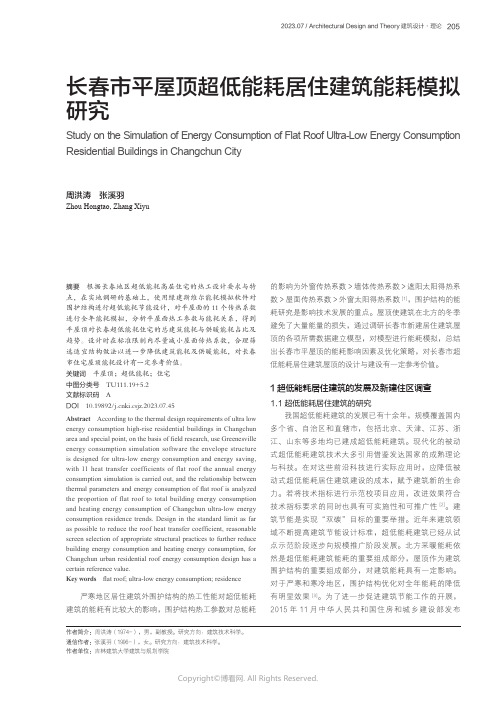
的影响为外窗传热系数>墙体传热系数>遮阳太阳得热系数>屋面传热系数>外窗太阳得热系数[1],围护结构的能耗研究是影响技术发展的重点。
屋顶使建筑在北方的冬季避免了大量能量的损失,通过调研长春市新建居住建筑屋顶的各项所需数据建立模型,对模型进行能耗模拟,总结出长春市平屋顶的能耗影响因素及优化策略,对长春市超低能耗居住建筑屋顶的设计与建设有一定参考价值。
1超低能耗居住建筑的发展及新建住区调查1.1超低能耗居住建筑的研究我国超低能耗建筑的发展已有十余年,规模覆盖国内多个省、自治区和直辖市,包括北京、天津、江苏、浙江、山东等多地均已建成超低能耗建筑。
现代化的被动式超低能耗建筑技术大多引用借鉴发达国家的成熟理论与科技。
在对这些前沿科技进行实际应用时,应降低被动式超低能耗居住建筑建设的成本,赋予建筑新的生命力。
若将技术指标进行示范校项目应用,改进效果符合技术指标要求的同时也具有可实施性和可推广性[2]。
建筑节能是实现“双碳”目标的重要举措。
近年来建筑领域不断提高建筑节能设计标准,超低能耗建筑已经从试点示范阶段逐步向规模推广阶段发展。
北方采暖能耗依然是超低能耗建筑能耗的重要组成部分,屋顶作为建筑围护结构的重要组成部分,对建筑能耗具有一定影响。
对于严寒和寒冷地区,围护结构优化对全年能耗的降低有明显效果[3]。
为了进一步促进建筑节能工作的开展,2015年11月中华人民共和国住房和城乡建设部发布摘要 根据长春地区超低能耗高层住宅的热工设计要求与特点,在实地调研的基础上,使用绿建斯维尔能耗模拟软件对围护结构进行超低能耗节能设计,对平屋面的11个传热系数进行全年能耗模拟,分析平屋面热工参数与能耗关系,得到平屋顶对长春超低能耗住宅的总建筑能耗与供暖能耗占比及趋势。
设计时在标准限制内尽量减小屋面传热系数,合理筛选适宜结构做法以进一步降低建筑能耗及供暖能耗,对长春市住宅屋顶能耗设计有一定参考价值。
关键词 平屋顶;超低能耗;住宅中图分类号 TU111.19+5.2文献标识码 ADOI 10.19892/ki.csjz.2023.07.45Abstract According to the thermal design requirements of ultra low energy consumption high-rise residential buildings in Changchun area and special point, on the basis of field research, use Greenesville energy consumption simulation software the envelope structure is designed for ultra-low energy consumption and energy saving, with 11 heat transfer coefficients of flat roof the annual energy consumption simulation is carried out, and the relationship between thermal parameters and energy consumption of flat roof is analyzed the proportion of flat roof to total building energy consumption and heating energy consumption of Changchun ultra-low energy consumption residence trends. Design in the standard limit as far as possible to reduce the roof heat transfer coefficient, reasonable screen selection of appropriate structural practices to further reduce building energy consumption and heating energy consumption, for Changchun urban residential roof energy consumption design has a certain reference val ue.Key words flat roof; ultra-low energy consumption; residence严寒地区居住建筑外围护结构的热工性能对超低能耗建筑的能耗有比较大的影响,围护结构热工参数对总能耗作者简介:周洪涛(1974-),男,副教授。
被动式建筑和超低能耗建筑的书籍
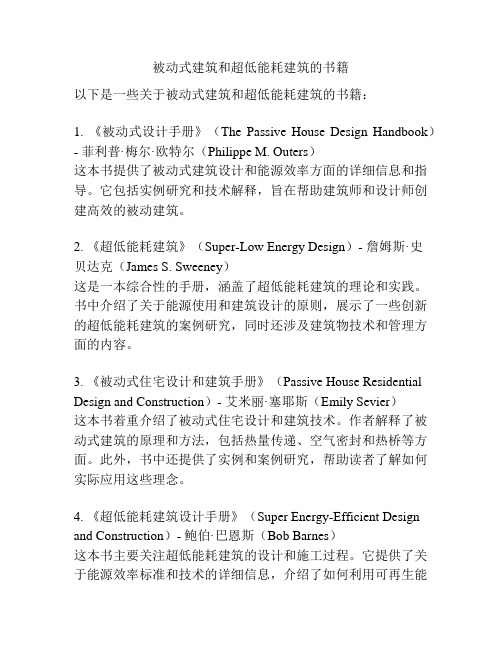
被动式建筑和超低能耗建筑的书籍以下是一些关于被动式建筑和超低能耗建筑的书籍:1. 《被动式设计手册》(The Passive House Design Handbook)- 菲利普·梅尔·欧特尔(Philippe M. Outers)这本书提供了被动式建筑设计和能源效率方面的详细信息和指导。
它包括实例研究和技术解释,旨在帮助建筑师和设计师创建高效的被动建筑。
2. 《超低能耗建筑》(Super-Low Energy Design)- 詹姆斯·史贝达克(James S. Sweeney)这是一本综合性的手册,涵盖了超低能耗建筑的理论和实践。
书中介绍了关于能源使用和建筑设计的原则,展示了一些创新的超低能耗建筑的案例研究,同时还涉及建筑物技术和管理方面的内容。
3. 《被动式住宅设计和建筑手册》(Passive House Residential Design and Construction)- 艾米丽·塞耶斯(Emily Sevier)这本书着重介绍了被动式住宅设计和建筑技术。
作者解释了被动式建筑的原理和方法,包括热量传递、空气密封和热桥等方面。
此外,书中还提供了实例和案例研究,帮助读者了解如何实际应用这些理念。
4. 《超低能耗建筑设计手册》(Super Energy-Efficient Design and Construction)- 鲍伯·巴恩斯(Bob Barnes)这本书主要关注超低能耗建筑的设计和施工过程。
它提供了关于能源效率标准和技术的详细信息,介绍了如何利用可再生能源和节能技术来降低建筑的能耗。
这些书籍都是关于被动式建筑和超低能耗建筑的权威指南,可帮助读者理解和应用这些概念和技术。
被动式超低能耗的建筑设计分析

内不存在滞风区域和涡流区域,夏季和过渡季节建筑前后 压差逸1.5Pa;冬季除去位于迎风面的建筑,其他建筑前后压差臆5Pa。
于建筑形体设计。本工程楼层高度 2.9m,建筑体系系 数分别是 0.35、0.32 和 0.34。户型设计充分考虑室内风对流 通道的形成,借助自然通风来降低建筑使用过程中的能耗。
中图分类号院TU201.5
文献标识码院A
文章编号院1006-4311(2021)17-0180-02
0 引言 现代建筑设计中,为实现节能降耗,被动式、超低能耗 等理念逐渐得到了推广应用,其借助气候特征、自然条件, 提高围护结构保温隔热、气密性能,减小建筑供暖供冷需 求,并通过新风热回收等技术,充分利用可再生能源,营造 舒适的室内环境。与主动式或其他类绿色建筑相比,被动式 建筑在地域适应等方面优势显著,具有可持续发展的意义。 1 被动式超低能耗建筑优势 被动式超低能耗建筑是一种特殊的建筑型式,其主要 优势体现在以下几个方面:淤温度恒定。借助被动式设计, 能够将建筑室内空间的温度始终维持在 20耀26益的区间 内,而且室内所有空间的温度基本一致,不存在明显的温 度梯度。于清洁卫生。被动式超低能耗建筑的门窗具备较 高的隔热性和气密性。避免门窗表面结露流水问题的同 时,也可以防止热桥现象。良好的保温隔热性能可以有效 避免内表面冷敷设给人们带来的不适感,能够规避结露发 霉的问题,可以为人们提供一个清洁卫生、健康宜居的环 境。盂安静舒适。相比较普通门窗,被动式超低能耗建筑采 用的高气密性门窗有着更加优越的隔音降噪效果,即便室 外十分嘈杂,室内也可以保持安静,而且在室内没有空调 内机的存在,避免了设备噪声的产生。相关统计数据显示, 被动式超低能耗建筑夜间室内噪音一般不会超过 30dB, 白天室内噪音不会超过 40dB,能够为业主提供安静舒适 的休息环境。榆空气洁净。被动式超低能耗建筑本身的高 气密性避免了室外污浊空气的进入,而新风设备中设置的 净化装置可以保证新风的洁净卫生,将室内空气维持在优 良状态。虞运行成本低廉。被动式超低能耗建筑的维护结 构具备良好的保温隔热性能,配合防热桥措施和热回收技 术等,节能性可达到 90%以上,能耗仅为普通建筑的 1/3 左右,极大减少运行成本。 2 被动式超低能耗的建筑设计策略与要点 2.1 设计策略
印制电路板可制造性设计评价模型与知识库
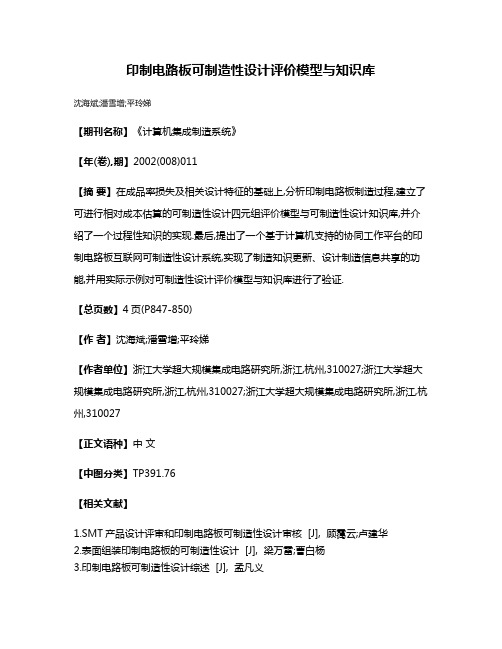
印制电路板可制造性设计评价模型与知识库
沈海斌;潘雪增;平玲娣
【期刊名称】《计算机集成制造系统》
【年(卷),期】2002(008)011
【摘要】在成品率损失及相关设计特征的基础上,分析印制电路板制造过程,建立了可进行相对成本估算的可制造性设计四元组评价模型与可制造性设计知识库,并介绍了一个过程性知识的实现.最后,提出了一个基于计算机支持的协同工作平台的印制电路板互联网可制造性设计系统,实现了制造知识更新、设计制造信息共享的功能,并用实际示例对可制造性设计评价模型与知识库进行了验证.
【总页数】4页(P847-850)
【作者】沈海斌;潘雪增;平玲娣
【作者单位】浙江大学超大规模集成电路研究所,浙江,杭州,310027;浙江大学超大规模集成电路研究所,浙江,杭州,310027;浙江大学超大规模集成电路研究所,浙江,杭州,310027
【正文语种】中文
【中图分类】TP391.76
【相关文献】
1.SMT产品设计评审和印制电路板可制造性设计审核 [J], 顾霭云;卢建华
2.表面组装印制电路板的可制造性设计 [J], 梁万雷;曹白杨
3.印制电路板可制造性设计综述 [J], 孟凡义
4.表面组装印制电路板基准标记的可制造性设计 [J], 梁万雷;周彤
5.基于印制电路板板级的可制造性设计分析 [J], 黄战武;李志娟;姜建国;叶强;曹玉因版权原因,仅展示原文概要,查看原文内容请购买。
基于能耗模拟计算的建筑方案优化
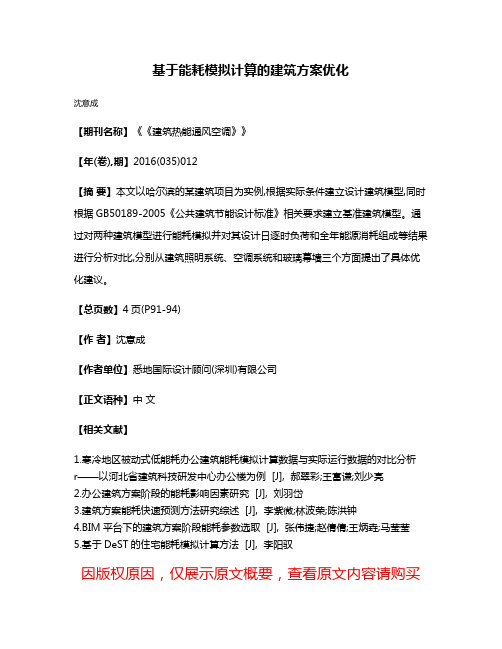
基于能耗模拟计算的建筑方案优化
沈意成
【期刊名称】《《建筑热能通风空调》》
【年(卷),期】2016(035)012
【摘要】本文以哈尔滨的某建筑项目为实例,根据实际条件建立设计建筑模型,同时根据GB50189-2005《公共建筑节能设计标准》相关要求建立基准建筑模型。
通过对两种建筑模型进行能耗模拟并对其设计日逐时负荷和全年能源消耗组成等结果进行分析对比,分别从建筑照明系统、空调系统和玻璃幕墙三个方面提出了具体优化建议。
【总页数】4页(P91-94)
【作者】沈意成
【作者单位】悉地国际设计顾问(深圳)有限公司
【正文语种】中文
【相关文献】
1.寒冷地区被动式低能耗办公建筑能耗模拟计算数据与实际运行数据的对比分析r——以河北省建筑科技研发中心办公楼为例 [J], 郝翠彩;王富谦;刘少亮
2.办公建筑方案阶段的能耗影响因素研究 [J], 刘羽岱
3.建筑方案能耗快速预测方法研究综述 [J], 李紫微;林波荣;陈洪钟
4.BIM平台下的建筑方案阶段能耗参数选取 [J], 张伟捷;赵倩倩;王炳垚;马莹莹
5.基于DeST的住宅能耗模拟计算方法 [J], 李阳驭
因版权原因,仅展示原文概要,查看原文内容请购买。
- 1、下载文档前请自行甄别文档内容的完整性,平台不提供额外的编辑、内容补充、找答案等附加服务。
- 2、"仅部分预览"的文档,不可在线预览部分如存在完整性等问题,可反馈申请退款(可完整预览的文档不适用该条件!)。
- 3、如文档侵犯您的权益,请联系客服反馈,我们会尽快为您处理(人工客服工作时间:9:00-18:30)。
Abstract Traditional single-core processors and multiprocessors architectures encounter some problems which are high heat generation, high cost to produce and high power consumption. In this paper, a model to achieve low power consumption by using several processors managed separately with useful energy saving strategies including switching the mode of processors, assign tasks to different CPUs, using optical fiber as transmitting media etc. is proposed. In this way, the architecture manages to disperse the energy dissipation. Some evaluations on power consumption, cost and performance are made which proves that it is an effective method to reduce the power consumption. Index Terms: optical interconnection; computer architecture; low power consumption; multiple processors © 2012 Published by MECS Publisher. Selection and/or peer review under responsibility of the International Conference on E-Business System and Education Technology
1. Introduction Traditional single core processors enjoyed a blooming period in the past four decades. In order to achieve a low power consumption, former designers tend to lower the voltage and smaller the size of chip. It is well recognized that processor clock frequency is the main concern factor of system performance. However, it becomes more and more difficult for us to raise the single core processor clock frequency because the cost to decrease the size of the chip is becoming higher and higher and the time to design and conform a new single core processor becomes longer and longer [1,2]. Thus, Chip Multiprocessor (CMP) organization becomes popular. CMP architecture which uses several simple processors organized in some key technology such as cache coherent design, kernel interconnection and multi-kernel tasks to some point increases the performance of computers, but heat generation and power consumption are problems that cannot be overlooked [3,4]. Symmetrical Multi-Processing (SMP) technology, one kind of CMP architecture, uses two or more identical processors are connected to a single shared main memory and are controlled by a single Operating System (OS)
I.J. Education and Management Engineering 2012, 4, 16-21
Published Online April 2012 in MECS () DOI: 10.5815/ijeme.2012.04.03 Available online at /ijeme
A Low Power Consumption Architecture Model for Multiple Processors on Optical Printed Circuit Board
Xinjiang Shaoa, Jian Liub, Jiyu Jinc, Zhisen Wang d, Nianyu Zoue
A Low Power Consumption Architecture Model for Multiple Processors on Optical Printed Circuit Board
17
instance. The SMP systems have a relatively strong advantage in distribute computing which means the performance of SMP systems are excellent [5]. But the transmit bandwidth limit their development. In addition, recent optical communication development is significant. The former trend of optical communications prefers to use it in a large scale of area. However, small-scale applications of optical communications become popular and low cost. Mu Hee Cho proposes a method for high-coupling-efficiency optical interconnection. In this way, we can develop optical printed circuit boards [6]. Patrick W. Dowd suggests an approach to improve the performance by using Wavelength Division Multiple Access (WDMA) technology [7]. Further, Biswanath Mukherjee presents the progress and challenges for optical communication networks which means that optical networks is developing at a very high speed [8]. Also, optical communication on board-level overcomes the shortage of heat generation comparing to wire commutation [9]. Hence, using optical fiber as bus media on board is a wise choice. In order to solve the above mentioned problems, we propose a low power consumption method by organizing several processors on an optical printed circuit board. This paper is organized as follows. Section II describes the whole architecture model. Section III evaluates the model in three different prospective. Finally, Section IV concludes. 2. Architecture model 2.1 Architectural features The architecture contains a number of processors and several memory and devices. Several crucial features are as follows. 1) The processors are arranged according to the structure of rectangular solid on the board. 2) One main processor controls the status and power of other processors. 3) Each of the processors is connected to at most one memory. 4) Each processor is connected to and one or a few input/output devices, so devices are controlled by the corresponding processors. 5) Using optical fiber as transmitting media, so the processors can use it to deliver control message or data. 2.2 Nodes Fig.1 illustrates the overall structure S which can be described as
